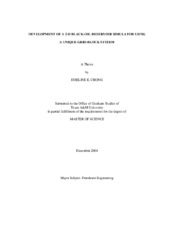Development of a 2-D black-oil reservoir simulator using a unique grid-block system
Abstract
The grid orientation effect is a long-standing problem plaguing reservoir simulators that employ finite difference schemes. A rotation of the computational grids yields a substantially different solution under certain circumstances. For example, in a five-spot pattern, the predicted recovery, water cut performance and the locations of the fronts depend on the type of grid system used. A Cartesian grid with one axis parallel to the line joining an injector and producer gives a solution significantly different from a grid that has the axes oriented at 45° to this line.
This study develops a unique grid-block assignment where rectangular grid blocks are interspersed with octagonal grid blocks. This grid block system is called the Hybrid Grid Block (HGB) system. The objective of this study is to evaluate the grid orientation effect of the HGB grid to see whether it is an improvement over the conventional Cartesian grid system.
In HGB, flow can progress in four directions in the octagonal grid blocks and two in the square grid blocks. The increase in the number of flow directions in the octagonal grid blocks is expected to reduce the grid orientation effect in the model. Hence, this study also evaluates the grid orientation effect of the HGB and compares it with the Cartesian grid system.
To test the viability of HGB, a general purpose finite difference IMPES-formulated two-dimensional black oil simulator was developed in this study, while retaining the familiar finite-difference discretization of the flow equations. Several simulation cases were conducted to compare HGB and conventional grid block systems. Comparisons with commercial simulator are also made. Despite the fact that the reservoir is isotropic and homogeneous, grid orientation effect was still observed when rectangular Cartesian grid models are run at mobility ratio, M = 1.0. Grid refinement can help to reduce the grid orientation effect in rectangular Cartesian grid models when there are favorable mobility ratios, i.e. M = 1.0 or less. However, at an unfavorable mobility ratio of M = 10.0, it is found that neither parallel nor diagonal orientation can be used reliably for the displacement problems run in this study. This is because as the number of grid blocks is increased, the performance of diagonal and parallel models actually diverges for the grid spacings investigated here. On the other hand, HGB grid is able to reduce the grid orientation effect even for unfavorable mobility ratio displacement problems (up to M = 50.0), with maximum relative difference in pore volume recovered of 6% between parallel and diagonal HGB grid models for all the cases run in this study. Comparisons between the conventional Cartesian and HGB grid show that the HGB grid is more effective in reducing the grid orientation effect than the Cartesian grid. The HGB grid performs better by consistently giving a smaller relative difference between HGB parallel grid and HGB diagonal grid in pore volume recovered (6.0, 4.5, 3.3, and 2.2%) compared to the relative difference between Cartesian parallel grid and Cartesian diagonal grid in pore volume recovered (17.0, 13.0, 9.3, 7.9%) at similar averaged area per grid block for all the four comparison cases studied.
Citation
Chong, Emeline E (2004). Development of a 2-D black-oil reservoir simulator using a unique grid-block system. Master's thesis, Texas A&M University. Texas A&M University. Available electronically from https : / /hdl .handle .net /1969 .1 /3334.


